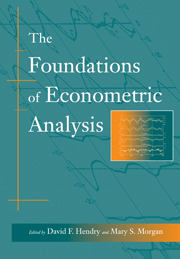Book contents
- Frontmatter
- Contents
- Preface
- Acknowledgements
- Introduction
- Bibliography
- I The Emerging Role of Econometrics in Economics
- II Early Time-Series Analysis
- 6 On the Study of Periodic Commercial Fluctuations (Read to the British Association in 1862, and in Investigations in Currency and Finance, Macmillan, 1884, pp. 3–10 and plates)
- 7 Correlation of the Marriage-Rate with Trade (Journal of the Royal Statistical Society, vol. 64, 1901, pp. 485–92)
- 8 The Correlation of Economic Statistics (Journal of the American Statistical Association, vol. 12, 1910, pp. 289–94, 306–17 (cut))
- 9 Why do we sometimes get Nonsense Correlations between Time-Series? (Journal of the Royal Statistical Society, vol. 89, 1926, pp. 2–9, 30–41)
- 10 On a Method of Investigating Periodicities in Disturbed Series, with Special Reference to Wolfer's Sunspot Numbers (Philosophical Transactions of the Royal Society of London, A, vol. 226, 1927, pp. 267–73)
- 11 A Random-Difference Series for Use in the Analysis of Time Series (Journal of the American Statistical Association, vol. 29,934, pp. 11–24 (data cut))
- 12 Calculation and Elimination of Seasonal Fluctuations [Berechnung und Ausschaltung von Saisonschwankungen] (Julius Springer, Vienna, 1936, chap. 1)
- 13 Morgenstern on the Methodology of Economic Forecasting (Journal of Political Economy, vol. 37, 1929, pp. 312–17, 320–3, 326–37 (cut))
- III Applied Econometrics and the Identification Problem
- IV The Evolution of Statistical Thinking in Econometrics
- V Dynamic Models
- VI The Tinbergen Debate
- VII Structure and Simultaneity
- VIII The Probabilistic Revolution
- IX Exogeneity
- Index
11 - A Random-Difference Series for Use in the Analysis of Time Series (Journal of the American Statistical Association, vol. 29,934, pp. 11–24 (data cut))
Published online by Cambridge University Press: 05 June 2012
- Frontmatter
- Contents
- Preface
- Acknowledgements
- Introduction
- Bibliography
- I The Emerging Role of Econometrics in Economics
- II Early Time-Series Analysis
- 6 On the Study of Periodic Commercial Fluctuations (Read to the British Association in 1862, and in Investigations in Currency and Finance, Macmillan, 1884, pp. 3–10 and plates)
- 7 Correlation of the Marriage-Rate with Trade (Journal of the Royal Statistical Society, vol. 64, 1901, pp. 485–92)
- 8 The Correlation of Economic Statistics (Journal of the American Statistical Association, vol. 12, 1910, pp. 289–94, 306–17 (cut))
- 9 Why do we sometimes get Nonsense Correlations between Time-Series? (Journal of the Royal Statistical Society, vol. 89, 1926, pp. 2–9, 30–41)
- 10 On a Method of Investigating Periodicities in Disturbed Series, with Special Reference to Wolfer's Sunspot Numbers (Philosophical Transactions of the Royal Society of London, A, vol. 226, 1927, pp. 267–73)
- 11 A Random-Difference Series for Use in the Analysis of Time Series (Journal of the American Statistical Association, vol. 29,934, pp. 11–24 (data cut))
- 12 Calculation and Elimination of Seasonal Fluctuations [Berechnung und Ausschaltung von Saisonschwankungen] (Julius Springer, Vienna, 1936, chap. 1)
- 13 Morgenstern on the Methodology of Economic Forecasting (Journal of Political Economy, vol. 37, 1929, pp. 312–17, 320–3, 326–37 (cut))
- III Applied Econometrics and the Identification Problem
- IV The Evolution of Statistical Thinking in Econometrics
- V Dynamic Models
- VI The Tinbergen Debate
- VII Structure and Simultaneity
- VIII The Probabilistic Revolution
- IX Exogeneity
- Index
Summary
It has several times been noted that time series commonly possess in many respects the characteristics of series of cumulated random numbers. The separate items in such time series are by no means random in character, but the changes between successive items tend to be largely random. This characteristic has been noted conspicuously in sensitive commodity prices. On the basis of the differences between chain and fixed-base index numbers King has concluded that stock prices resemble cumulations of purely random changes even more strongly than do commodity prices.
The fact that series commonly used as indexes of business activity closely resemble series obtainable by cumulating random numbers has given support to the theory that so-called business cycles result in large degree from cumulative effects of independent random influences bearing on the business situation – some favourably, some unfavourably.
In the discussion which follows, a series such as may be obtained by cumulating random numbers will for brevity and clarity be called usually a random-difference series, since it is the first differences of the series and not the items of the series itself which are random. The natural alternative term of cumulated random series is subject to misinterpretation as describing a series that is itself random.
Economic theory has fallen far short of recognizing the full implications of the resemblance of many economic time series to random-difference series; and methods of statistical analysis in general use have given these implications virtually no recognition.
- Type
- Chapter
- Information
- The Foundations of Econometric Analysis , pp. 166 - 174Publisher: Cambridge University PressPrint publication year: 1995

